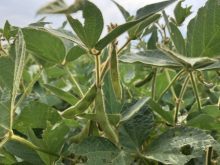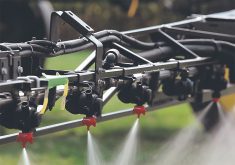SASKATOON – In Saskatchewan, 350,000 acres of farmland are under irrigation.
But organizers of the 15th Annual Saskatchewan Irrigation Conference in Saskatoon say it is not enough.
They believe the province has enough land and water to more than triple that number.
“The water is there. The land is there,” said Saskatchewan Irrigation Projects Association chair Roger Pederson, from Outlook. “The potential is almost unlimited.”
Irrigation farmers from across the province and the country gathered for a two-day event held in Saskatoon Dec. 7-8, which was organized by SIPA and the Irrigation Crop Diversification Corporation.
Read Also

No special crop fireworks expected
farmers should not expect fireworks in the special crops market due to ample supplies.
Intensified irrigation in the province started in earnest after the completion of the Gardiner Dam in 1967. Just under half of Saskatchewan’s irrigated land is still connected to that dam and Lake Diefenbaker.
John Linsley from Agriculture Canada estimates that irrigation uses only five percent of the available water from the man-made lake. He said that around Lake Diefenbaker there is a half million acres of potential irrigation expansion. That is just a fraction of the 1.5 million acres irrigation advocates are hoping to get under water province wide.
“Those who have access to water are up taking irrigation as fast as their farm cash flows will allow them,” said Linsley. “It is growing.”
There are about 2,000 to 3,000 farmers using irrigation in Saskatchewan, well below the nationwide averages. But unlike Alberta, where water shortages and scarcity have put a stop to irrigation expansion, Saskatchewan has room for growth.
“The research shows that the contribution to the provincial economy is about five times the (gross domestic product) from an irrigation farm to a dryland farm,” said Pederson. “It could be pretty significant in the long term, especially if we are able to develop several hundred thousand more acres of irrigation.”
Ross McKenzie is a professor of agronomy and agriculture at the University of Lethbridge who focuses on irrigation. He said that although modern techniques such as pivot irrigation systems and better pipelines are improving crop yields, farmers have to be careful and precise when it comes to irrigation.
“Fifty years ago we were irrigating with a shovel,” he said in an interview after his presentation. “Now if you are going to be using pivot irrigation, the input costs are much higher to optimize your yield…. There is lots of opportunity for error, but guys that are careful with their management going through irrigation can actually do very well.”
McKenzie and his colleague Shelly Woods, who focuses on water management at the University of Lethbridge, were at the conference explaining the intricacies of irrigation.
“In the old days, a lot of guys irrigated because their neighbour was irrigating or because the guy at the coffee shop said it was time to irrigate,” Woods said. “More and more we are educating people about timing their irrigation, about measuring the moisture in the soil.”
Woods and her team at the U of L have conducted extensive studies about the amount of water needed for particular plant varieties. Her research shows that paying close attention to the amount of water and the timing can greatly improve yields.
Her advice is to have a strategy and stick to it.
“Irrigated crops produce higher yields,” Woods said. “But you have to pay attention to crop output per unit of water.”
McKenzie’s research has focused on ways irrigation farmers can maximize output. His first words of advice are simply to get seeds in the ground earlier.
“For cereal crops there is no reason why we can’t be seeding in the first two weeks of April,” he said.
McKenzie is referring to farms in his home region of southern Alberta, but he said farmers in Saskatchewan also might be seeding too late.
He also said that increasing seed rate or the number of seeds per square foot could increase irrigation farmer’s yields of some crops by 20 or even 40 percent.














